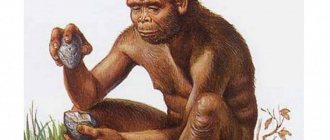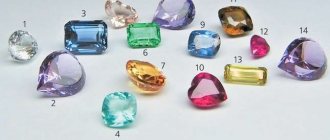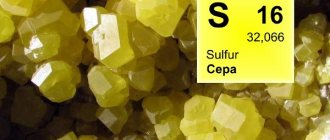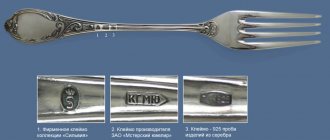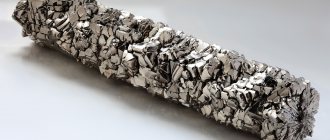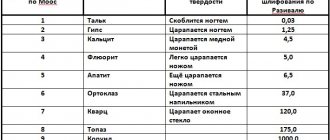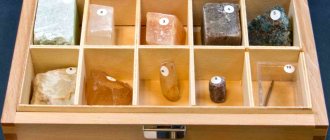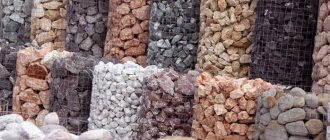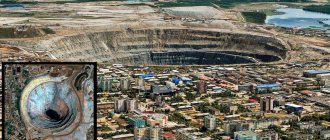Nature gives man the opportunity to use the benefits it produces. Therefore, people live quite comfortably and have everything they need. After all, water, salt, metals, fuel, electricity and much more - everything is created naturally and is subsequently transformed into the form necessary for humans.
The same applies to natural products such as minerals. These numerous diverse crystal structures are important raw materials for a huge variety of industrial processes in human economic activity. Therefore, let’s look at what types of minerals there are and what these compounds generally are.
Minerals: general characteristics
In the generally accepted sense in mineralogy, the term “mineral” is understood as a solid body consisting of chemical elements and possessing a number of individual physicochemical properties. In addition, it should be formed only naturally, under the influence of certain natural processes.
Minerals can be formed both by simple substances (native) and complex ones. The ways of their formation are also different. There are such processes that contribute to their formation:
- igneous;
- hydrothermal;
- sedimentary;
- metamorphogenic;
- biogenic.
Large aggregates of minerals collected into single systems are called rocks. Therefore, these two concepts should not be confused. Rock minerals are extracted by crushing and processing entire pieces of rock.
The chemical composition of the compounds in question may be different and contain a large number of different impurity substances. However, there is always one main thing that dominates the lineup. Therefore, it is this that is decisive, and impurities are not taken into account.
Relationship between relief and mineral resources of the Russian Federation
The territory of Russia is extremely complex and diverse due to its large extent from west to east and from south to north. Huge territories unite different terrains, rich in a full range of PIs:
- plains in the European and central region;
- mountains in the south, east and northeast, as well as the unique Ural range that crosses the country;
- northern slope with waters flowing into the seas of the Arctic Ocean.
Due to the unique geographical location, diversity of relief forms and natural zones, almost all known minerals have formed on the territory of the country.
Types of minerals
The following classification can be given, which reflects the main part of the composition of the mineral.
- Native or simple substances. These are also minerals. Examples are as follows: gold, iron, carbon in the form of diamond, coal, anthracite, sulfur, silver, selenium, cobalt, copper, arsenic, bismuth and many others.
- Halides, which include chlorides, fluorides, bromides. These are minerals, examples of which are known to everyone: rock salt (sodium chloride) or halite, sylvite, fluorite.
- Oxides and hydroxides. They are formed by oxides of metals and non-metals, that is, by combining them with oxygen. This group includes minerals whose names are chalcedony, corundum (ruby, sapphire), magnetite, quartz, hematite, rutile, cassematite and others.
- Nitrates. Examples: potassium and sodium nitrate.
- Borates: optical calcite, eremeyevite.
- Carbonates are salts of carbonic acid. These are minerals whose names are as follows: malachite, aragonite, magnesite, limestone, chalk, marble and others.
- Sulfates: gypsum, barite, selenite.
- Tungstates, molybdates, chromates, vanadates, arsenates, phosphates are all salts of the corresponding acids that form minerals of various structures. Names: nepheline, apatite and others.
- Silicates. Salts of silicic acid containing the SiO4 group. Examples of such minerals are the following: beryl, feldspar, topaz, garnets, kaolinite, talc, tourmaline, jadeine, lapis lazuli and others.
In addition to the above-mentioned groups, there are also organic compounds that form entire natural deposits. For example, peat, coal, urkite, calcium and iron oxolates and others. As well as several carbides, silicides, phosphides, and nitrides.
Other types of stone classification
By form of origin:
- Natural - organic (pearl, amber and coral) and mineral (topaz, limestone, rock crystal, marble, jasper and granite).
- Artificial - organic (artificial pearls) and mineral (diamond, sapphire and ruby).
By purpose:
- Ornamental
- Decorative
- Jewelry stones
- Construction
By degree of hardness:
- Hard stones (7-10), including amethyst, diamond, agate, aventurine, jadeite, granite, turquoise, amethyst, amazonite, basalt, jasper, topaz, rhodonite, obsidian, lapis lazuli, orthoclase, opal, lapis lazuli, flint and corundum.
- Medium-hard (4-6) - fluorite, jade, marble, malachite, marbled limestone, dolomite and azurite.
- Soft (no more than 3 points on the Mohs scale) - amber, talc, slate, serpentine, selenite, sandstone, marl, calcite, ordinary limestone, jet and alabaster.
Native elements
These are minerals (photos can be seen below) that are formed by simple substances. For example:
- gold in the form of sand and nuggets, ingots;
- diamond and graphite are allotropic modifications of the carbon crystal lattice;
- copper;
- silver;
- iron;
- sulfur;
- group of platinum metals.
Often these substances occur in the form of large aggregates with other minerals, pieces of rock and ores. Extraction and their use in industry are important for humans. They are the basis, the raw material for obtaining materials from which a variety of household items, structures, decorations, devices, etc. are subsequently made.
Types of natural resources
Everything that nature has created inside the earth's crust - minerals, rocks, etc. - has its own classification. If we consider the division according to physical condition, then these could be:
- solids;
- liquids;
- gases.
There is another method that involves analyzing their use. According to him, fossils are:
- flammable;
- ore;
- nonmetallic;
- salt;
- precious and semi-precious stones.
Another characteristic is the origin of the fossils. They are divided into the following categories:
- Igneous. They tend to occur in folded reliefs, since such ores can be formed when released from rapidly cooling lava. During tectonic shifts, masses shift to the lower edge of the platform, forming a layer of rock. These are mainly ore minerals. An example of a territory with a reserve of iron compounds is a deposit in the Kursk region, called a magnetic anomaly, or the Ukrainian Krivoy Rog basin.
- Sedimentary rocks include nonmetallic elements. They appear on the shores of shallow seas, as well as in lake or swampy areas. They originated from ancient organic remains, algae and land plants.
- Metamorphic ones occur when the earth's platforms shift and physical and chemical changes occur within the Earth. The main representatives of this category are all kinds of slates.
There are several methods for extracting natural resources. Depending on the level of occurrence, these can be:
- Open pit mining for extracting mountain deposits is the most economically feasible method, but it leads to changes in topography, which is not always beneficial to the ecosystem.
- The mine option will require large expenses.
- For oil, a fountain is traditional, when the liquid comes out under the pressure of gases.
- Ore is extracted using a special method - geotechnological. To do this, hot water or a special solution is pumped into the rock layers. Through the wells, the contents come to the surface and the valuable rock is separated.
All countries are experiencing an increase in demand for minerals. In order to make the most effective and complete use of such exhaustible wealth, there are several rules:
- Reduce mining losses.
- Maximum extraction of raw materials at each deposit.
- Development of new cost-effective extraction methods.
- Use of modern technology.
- Involving scientists to search and predict future deposits.
Phosphates, arsenates, vanadates
This group includes rocks and minerals that are predominantly exogenous in origin, that is, found in the outer layers of the earth’s crust. Only phosphates are formed inside. There are actually quite a lot of salts of phosphoric, arsenic and vanadic acids. However, if we consider the overall picture, then in general their percentage in the bark is small.
There are several of the most common crystals that belong to this group:
- apatite;
- vivianite;
- lindakerite;
- rosenite;
- carnotite;
- Pascoite.
As already noted, these minerals form rocks of quite impressive size.
Place of Birth
If you look at a detailed map of mineral deposit zones in the Russian Federation, you will see the following picture:
- gold is concentrated mostly in Yakutia, in the Far East in the Magadan region, there are also 200 primary and 114 complex deposits;
- combustible resources (oil and gas) are found to the greatest extent in the north of Western Siberia, in the Yamalo-Nenets District, and also partially in the Volga delta and Sakhalin;
- silver is present in large quantities in the Urals and East Siberia;
- non-metallic construction materials are scattered beyond the Urals, in the Sayans, Transbaikalia, in the Krasnoyarsk Territory and Irkutsk Region;
- coal is distributed relatively evenly, but most of it is located beyond the Urals;
- oil shale is most common in the European part of the country, in the Baltic basin;
- iron ores are mined in the Kursk region, on the Kola Peninsula and the Baltic Shield;
- uranium is mined in Transbaikalia;
- carbonate manganese is also common in Siberia, the Urals and the Far East;
- aluminum is most concentrated in Western Siberia and the Urals;
- non-ferrous metals are most concentrated in the region of Eastern Siberia and Taimyr.
Precious and semi-precious stones and non-metallic materials are widespread in the mountain layers of the Urals and Siberia, and there are especially many of them in the Altai and Sayan Mountains.
Oxides and hydroxides
This group of minerals includes all oxides, both simple and complex, which are formed by metals, nonmetals, intermetallic compounds and transition elements. The total percentage of these substances in the earth's crust is 5%. The only exception, which relates to silicates and not to the group under consideration, is silicon oxide SiO2 with all its varieties.
You can give a huge number of examples of such minerals, but we will indicate the most common:
- Granite.
- Magnetite.
- Hematite.
- Ilmenite.
- Columbite.
- Spinel.
- Lime.
- Gibbsite.
- Romaneshit.
- Holfertitis.
- Corundum (ruby, sapphire).
- Bauxite.
Basic classification
Minerals with a homoatomic structure
Total content in soil (3.7%). These are native crystalline formations (silver, gold, platinum), as well as intermetallic compounds (graphite, diamond, sulfur).
About forty crystalline entities with different chemical structures have been found in nature. However, most of them are extremely rare in natural conditions.
In nature, native metals can be found in the form of Al, Zn, Hg, Sn, Pb, Fe, Cu, Ag, Pt, Au - and compounds of several metal units (Pt+Fe+Ni) are considered typical and widespread.
There are also native semimetals (intermetallic compounds), among which the most common are Te, Se, Sb and As. Among native non-metallic rocks, C-modifications such as diamond and graphite, as well as S-integrity, can be distinguished. Sulfur and graphite, as a rule, are involved in the formation of especially large natural deposits.
Sulfides
Total content in soil (16%). Chalcogenides or, as they are also called, sulfur compounds. Essentially, these are formations of cations with sulfides (with sulfur). To date, more than two hundred sulfur compounds have been isolated. However, only 10% of them were found in significant quantities. Their most striking representatives are sulfide compounds with Hg, Sb, Zn, Pb, Cu, Fe.
Sulfides vary in color and are represented in nature in black, lead-gray, yellow-brass, orange, yellow-copper, red and yellow shades. The hardness of such varieties on the Mohs scale is 1-6.5, and the density varies between medium and high values.
Most sulfides are formed during geothermal processes, but there are also varieties with metamorphic igneous genesis. Even less common are sulfide mineral compounds formed as a result of exogenous processes.
They are most in demand in the ore industry, as well as as raw materials for the production of heavy, non-ferrous, dispersed and individual rare metals and metal alloys.
Oxygen-based compounds
Total content in soil (75%). Oxides and hydroxides belong to the class of minerals with oxygen compounds. In addition to oxygen, hydroxides contain water. A little less than 20% of such compounds from the total number of known minerals were found in the earth's crust. Of these, 12% is occupied by silica, and hydroxides and oxides – almost 4%. The most common minerals in this category are hydroxides and oxides of titanium, manganese and aluminum.
The presented minerals differ in their physical properties. Most of them have a high hardness index. By nature of origin these are hydrothermal, pegmatite and igneous rocks. However, most of the oxides are formed under the influence of exogenization in the upper lithospheric layers.
During the weathering process, endogenous varieties are subject to chemical destruction with the transition to hydroxides and oxides - these compounds are more resistant to surface conditions. In terms of their chemical and physical structure, many types of oxides are very stable, as a result of which they gradually accumulate in placers.
Also, the table of minerals classifying this category includes sulfates, silicates, phosphates and carbonates.
Carbonates
This class of minerals includes a fairly wide variety of representatives, which also have important practical significance for humans. So, there are the following subclasses or groups:
- calcite;
- dolomite;
- aragonite;
- malachite;
- soda minerals;
- bastnäsite.
Each subclass includes from several units to dozens of representatives. In total there are about one hundred different mineral carbonates. The most common of them:
- marble;
- limestone;
- malachite;
- apatite;
- siderite;
- Smithsonite;
- magnesite;
- carbonatite and others.
Some are valued as a very common and important building material, others are used to create jewelry, and others are used in technology. However, all are important and are being mined very actively.
Main classes of jewelry stones
Jewelry stones are mineral aggregates and natural minerals that are used in the production of jewelry. As a rule, these are rarely found in nature, highly decorative stones with good wear resistance. Modern jewelry production works with more than 300 varieties of natural mineral varieties.
Jewelry minerals are divided according to the main feature - traditionality:
- Traditional - those stones that have been used since ancient times in the production of jewelry, including heliodor, sapphire, aquamarine, alexandrite, emerald, ruby, diamond, opal, garnet minerals, topaz, spinel, feldspars and quartz (zircon, diopside, chrysolite , lapis lazuli, turquoise, malachite, rhodonite, jade, jadeite, jasper, serpentine, obsidian).
- Non-traditional stones are those stones that have recently begun to be used for jewelry design. These include dianite, tanzanite and charoite.
Silicates
The most diverse group of minerals in terms of external forms and number of representatives. This variation is due to the fact that silicon atoms, which form the basis of their chemical structure, are capable of combining into different types of structures, coordinating several oxygen atoms around themselves. Thus, the following types of structures can be formed:
- island;
- chain;
- tape;
- leafy.
These minerals, photos of which can be seen in the article, are known to everyone. At least some of them. After all, these include the following:
- topaz;
- pomegranate;
- chrysoprase;
- rhinestone;
- opal;
- chalcedony and others.
They are used in jewelry and are valued as durable structures for use in technology.
We can also give examples of minerals, the names of which are not so well known to ordinary people not associated with mineralogy, but nevertheless they are very important in industry:
- Datonite.
- Olivine.
- Murmanite.
- Chrysocol.
- Eudialyte.
- Beryl.
general information
Russia, having the largest territory in comparison with other countries, occupies a leading position in the extraction of essential minerals. The total number of deposits is more than 200,000, and this number is constantly increasing as methods for searching for new deposits are improved. The value of the estimated resources is over 30 trillion. dollars. The amount of natural gas and coal beats the records of most other countries: they represent 32% and 30%, respectively, of the total world reserves.
